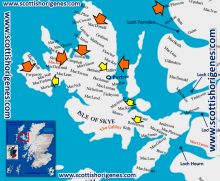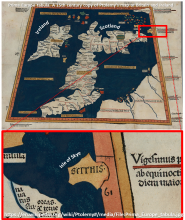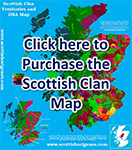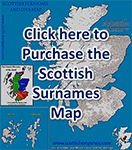You are here
The Isle of Skye ‘the Genetic Heartland of the Scots’
 Previous Scottish Origenes research has revealed how the Irish and Scottish Gaels share a common origin within the Rhineland of Central Europe, and that the progenitors of both groups sought refuge from Roman Conquest within Britain. However, the subsequent Roman conquest of Britain forced them ever further north, with the ancestors of the Scots Gaels crossing the Firth of Forth and the Clyde Estuary into the Highlands of Northern Scotland, and the ancestors of the Irish Gaels crossing into Ireland (to read about that journey click here). Further recent BigY SNP testing has revealed that it was in the Isle of Skye that the ancestors of the Scottish Gaels would ultimately settle.
Previous Scottish Origenes research has revealed how the Irish and Scottish Gaels share a common origin within the Rhineland of Central Europe, and that the progenitors of both groups sought refuge from Roman Conquest within Britain. However, the subsequent Roman conquest of Britain forced them ever further north, with the ancestors of the Scots Gaels crossing the Firth of Forth and the Clyde Estuary into the Highlands of Northern Scotland, and the ancestors of the Irish Gaels crossing into Ireland (to read about that journey click here). Further recent BigY SNP testing has revealed that it was in the Isle of Skye that the ancestors of the Scottish Gaels would ultimately settle.
For those males that carry a Scottish Gael Y-DNA genetic signature, their most distant genetic matches in the BigY DNA test results will be dominated by Scottish surnames like Campbell, Stewart, MacDonald, MacPhersons, MacKay and Robertsons (see attached BigY500 results image).  Those surnames are DNA linked through a definitive shared paternal ancestry; those surnames literally arose among a tribal group of related males living in a specific part of Scotland. Since Scottish surnames still concentrate in the area that they first appeared, one can examine the origin of the Campbell, Stewart, MacDonald, MacPhersons, MacKay and Robertsons surnames and identify an area common to all. When that is done, it leads ultimately to the ‘Isle of Skye.’
Those surnames are DNA linked through a definitive shared paternal ancestry; those surnames literally arose among a tribal group of related males living in a specific part of Scotland. Since Scottish surnames still concentrate in the area that they first appeared, one can examine the origin of the Campbell, Stewart, MacDonald, MacPhersons, MacKay and Robertsons surnames and identify an area common to all. When that is done, it leads ultimately to the ‘Isle of Skye.’  It is the Isle of Skye which marks the epicentre of the Scottish Gaelic male. More precisely, it was on the northern tip of the Isle of Skye that a Celtic Proto-Gael tribal group finally found refuge from Roman Conquest (see attached Surnames of Skye image, taken from the Surnames of Scotland map click here). How many settled in Skye nearly 2,000 years ago is unknown, but their DNA reveals that they were a closely related group, with families, including warriors, wives, and children all from a tribal area between the Moselle and Rhine Rivers in Central Europe.
It is the Isle of Skye which marks the epicentre of the Scottish Gaelic male. More precisely, it was on the northern tip of the Isle of Skye that a Celtic Proto-Gael tribal group finally found refuge from Roman Conquest (see attached Surnames of Skye image, taken from the Surnames of Scotland map click here). How many settled in Skye nearly 2,000 years ago is unknown, but their DNA reveals that they were a closely related group, with families, including warriors, wives, and children all from a tribal area between the Moselle and Rhine Rivers in Central Europe.
 The Isle of Skye is interesting for a number of reasons, it is marked ‘Scithis’ on Ptolemys map which was produced nearly 2,000 years ago (see attached Medieval reproduction of Ptolemys Britain and Ireland image). On Ptolemys map, the Isle of Skye is literally on the edge of the known world, and therefore an ideal refuge from Rome. The Isle of Skye may also explain the confusion that has arisen regards the origin of the Scots, who traditionally have always been regarded as a tribal group from Ireland who invaded and conquered mainland Scotland. The massive flaw in that theory is that Gaelic Scottish males have absolutely no DNA evidence whatsoever to show an earlier origin within Ireland (think about it, if they did, then their most distant BigY matches would be dominated by Irish surnames like Murphy, O’Connor and O’Neill). It makes more sense that the Ancient Britons, Picts, Romans and later Anglo-Saxons who first encountered these Gaelic speaking raiders named them ‘Scots’ in reference to that big island off the Scottish west coast known as ‘Scithis.’
The Isle of Skye is interesting for a number of reasons, it is marked ‘Scithis’ on Ptolemys map which was produced nearly 2,000 years ago (see attached Medieval reproduction of Ptolemys Britain and Ireland image). On Ptolemys map, the Isle of Skye is literally on the edge of the known world, and therefore an ideal refuge from Rome. The Isle of Skye may also explain the confusion that has arisen regards the origin of the Scots, who traditionally have always been regarded as a tribal group from Ireland who invaded and conquered mainland Scotland. The massive flaw in that theory is that Gaelic Scottish males have absolutely no DNA evidence whatsoever to show an earlier origin within Ireland (think about it, if they did, then their most distant BigY matches would be dominated by Irish surnames like Murphy, O’Connor and O’Neill). It makes more sense that the Ancient Britons, Picts, Romans and later Anglo-Saxons who first encountered these Gaelic speaking raiders named them ‘Scots’ in reference to that big island off the Scottish west coast known as ‘Scithis.’
How the Isle of Skye (Scithis) became confused with Ireland (Hibernian) is a mystery. While the Irish and Scottish Gaels share a common origin (Rhineland) language (Gaelic), Surnames (Mac/Mc), sport (Hurling/Shinty) and national drink (Whiskey/Whisky), it is the Isle of Skye, among all the islands of Western Scotland that features most prominently in Irish mythology and folklore (in the Ulster Cycle the champion Cúchulainn travels to the Isle of Skye to learn the art of combat). This shared folklore implies that the Gaels in Ireland and on the Isle of Skye were well aware of their shared origin, and of their common exile to Islands off the coast of mainland Britain. Intriguingly, the Scottish Gaelic Clan Chattan, whose territory lay on the mainland to the east of Skye, have a origin folklore that claims descent from the ‘Catti’ who were a tribe of Gauls who had been driven out by the Romans (which is remarkably similar to the story revealed by the DNA of the Scottish Gaels).
The Gaels on the Isle of Skye would thrive in their island hideaway; using their island home to raid the Roman settlements throughout Britain. They would later convert to Christianity through contact with their Gaelic cousins from Ireland, and with the collapse of Roman Britain, the Scithis Gaels would pour out from their island home and conquer and settle throughout the Highlands and much of the Scottish Lowlands. When it was time for uniting the nation, it was the Kingship and Folklore of the 'Scithis' or 'Scots' that would be adopted by the new rainbow 'Scottish/Scithis' nation of Gaels, Britons, Roman settlers, Anglo-Saxons, Vikings, Norse and Normans. Not bad for a bunch of refugees from Central Europe. Contact Scottish Origenes (CLICK HERE) to find out about commercial ancestral DNA testing or for a FREE CONSULTATION on your DNA results.






